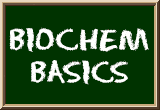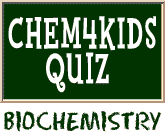
Biochemistry and Organic Chemistry
Some of you may have heard about organic chemistry. It's a much broader field than biochemistry. It looks at every molecule that might have a carbon atom. You could be studying plastics, cellulose, gasoline, fats in your cells, or paint. Organic chemistry looks at many carbon-containing compounds beyond the ones found in living systems.Biochem Versus O-Chem
Ahhh, the battle of the heavyweights. It is true that almost all compounds in biochemistry have carbon atoms. But there are many more activities on Earth that use carbon and have nothing to do with life. Look at the series of minerals called carbonates (-CO3). They all have carbon compounds that mix with trace elements. Some examples of carbonates are Calcite, Dolomite, and Smithsonite. Even geologists need to understand chemistry.We like biochemistry because we learn about things that are inside of us. We can relate to what happens when we eat and how our bodies are constructed. We can imagine how the molecules are moving around the mitochondria or chloroplasts, as opposed to chemical changes that make natural gas. If you choose a career in biology or chemistry, you will need to understand the information in both biochemistry and organic chemistry. Why? Because the movement of atoms in the bio-chem world follows the same rules you will learn in o-chem.
The Chemistry of Art
What if you love making art? Can you escape organic chemistry? Ummm... Probably. But the people who make your materials will not. You need to understand chemistry to make different types of paints and chemicals you will use every day in your studio. If you paint, you will definitely hear about titanium (Ti) white, cobalt (Co) blue, and cadmium (Cd) red. While not all of those pigments have carbon compounds, you definitely be using mediums and solvents when you work with the paints. That's all organic chemistry.Carbon and Other Worlds
Organic chemistry might only be big on our planet. Life on Earth is based on carbon compounds. O-chem crosses over into almost every field of chemistry (except inorganic chemistry). So, when we say it's big here, we really mean it. Other planets may have life based on silicon (Si) or have environments based on sulfur (S). Did you know that some organisms can survive with reactions that include hydrogen sulfide (H2S) instead of water (H2O)? Scientists are looking at similar organisms at the bottom of the ocean and in aquatic areas without oxygen (anoxic).Related Video...
Chalk Talk: Polymers (US-NSF Video)
Encyclopædia Britannica: Organic Chemistry
Wikipedia: Organic CHemistry
Encyclopedia.com: Organic Chemistry



